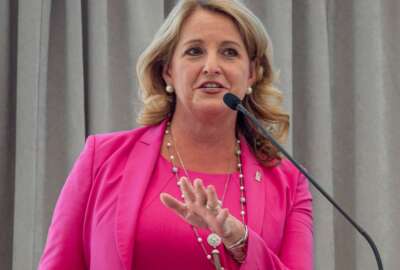

Hubbard Radio Washington DC, LLC. All rights reserved. This website is not intended for users located within the European Economic Area.
The Government Accountability Office found GSA will not recover the costs to run the Technology Modernization Fund until 2025 and highlighted other delays in th...
When it comes to reports from the Government Accountability Office, a strong majority of the time agencies go along to get along. Disagreeing with auditors just isn’t worth the effort, most federal managers would agree.
But when there are cases where aggressively pushing back is almost mandatory, well, watching from the sidelines—like most of us do—is a fascinating experience.
This is the case with GAO’s recent report on the implementation of the Technology Modernization Fund (TMF).
The Office of Management and Budget and the General Services Administration didn’t just dispute GAO’s conclusions, but sought to discredit the report altogether.
In one case, OMB’s Deputy Director for Management Margaret Weichert said in a letter responding to the draft report that GAO’s facts, assumptions and recommendations are misleading, at best, and paints an incomplete picture of the TMF.
GSA Administrator Emily Murphy, a former Congressional staff member, used a lighter touch in her response letter, but still used words like “shortsighted” about GAO’s findings and expressed “concerns” over auditors’ conclusions.
While the forcefulness of the response likely is because OMB and GSA truly disagree with the results and methodology, there is a definite part of the response because of how the Senate, in particular, has not supported the TMF over the last two years.
In fiscal 2019, the administration asked for $210 million. The House approved $150 million in its initial allocation and the senate zeroed out the fund totally. In the end, the TMF Board had $25 million to loan out.
In 2020, the White House asked for $150 million and so far the House approved $35 million and the Senate, once again, zeroed out the funding.
So a negative GAO report may not bode well as lawmakers finish up the 2020 spending bills this week. The final version of this year’s spending bill includes $25 million for TMF.
“OMB will continue to leverage the TMF to drive administration and congressional IT modernization priorities,” Weichert wrote in response to GAO’s report. “We encourage Congress to provide the necessary funds to the TMF so OMB and GSA can more effectively manage the legitimate operational issues caused by underfunding the TMF, and most importantly, to ensure that the TMF will remain a key lever to drive transformational change in citizen service delivery that taxpayers deserve.”
OMB also told GAO that some of the TMF’s challenges were because Congress hadn’t approved the $438 million the administration requested in fiscal 2018 and 2019.
GSA’s Murphy furthered the case for Congress to fund the program.
She wrote, “The TMF is operating as intended by Congress—agencies are using the awarded funds from the TMF for critical modernization projects that will enhance mission performance and the high quality of citizen-facing applications.”
The need to make their case both through their likely coordinated response to GAO and in public is clear as auditor’s assessment of the TMF wasn’t pretty.
In the highlights of the report, GAO says GSA is spending $1.2 million to oversee and manage the fund, but fees charged to the agencies receiving the loans totaled about 3% or $33,000 leaving the program management office deep in the red. GAO says GSA will not cover its administrative costs for the TMF until 2025 based on the current rate of fees collected.
But it’s more than concerns about GSA’s ability to pay for the program management office, if you dig deeper into the report—which is questionable whether lawmakers and their staff actually will—you will see four of the projects are delaying the requesting of funds from the board. The Agriculture Department’s Farmers.gov portal will not ask for the final $6 million of its $10 million loan until 2020. USDA also is asking for only $500,000 total out of the $4.5 million the board awarded for its infrastructure optimization project.
The departments of Energy and Housing Urban Development also are either delaying the payout of their loans or now asking for less overall.
This means four out of the nine projects already are facing scope changes. This seems to support GAO’s claim that agencies didn’t do a good enough job estimating costs and savings.
“Based on our analysis of the cost estimates for the seven TMF-funded projects, the reported savings estimates that were derived from those estimates cannot be considered reliable. Officials responsible for developing the cost estimates for each of the projects did not incorporate all of the best practices for a reliable cost estimate, as defined in the GAO guidance and OMB Circular A-11,” GAO states.
The entire premise of the TMF is for it to be a revolving fund where agencies pay back the loans so others can apply for money in the future.
“Agency officials responsible for developing the cost estimate for each of the seven projects all confirmed that they were instructed to use the project cost estimate template to report their projects’ cost and savings estimates,” GAO states. “In addition, these officials acknowledged that they did not follow their own internal cost estimate development processes or GAO best practices when developing their estimates.”
This is also one area where GSA and OMB pushed back against GAO’s conclusions.
Weichert said agencies do not have to necessarily follow GAO’s cost estimating guide, and instead must follow those requirements set out in Circular A-11.
Weichert said in her letter that in regards to the requirement to follow GAO’s cost estimating guide, “we informed GAO at every available opportunity that simply isn’t true.”
Similar to what OMB said with the Antideficiency Act, GAO can make suggestions, but that’s all they are because of the constitutional doctrine of the separation of powers between the different branches of government.
GAO rebuked this change in policy.
“Since OMB first introduced its cost estimating appendix to Circular A-11 in 2006, the circular has stated that the appendix is based on the GAO cost estimating guide,” auditors wrote. “Specifically, the circular stated that the appendix is based on GAO’s ‘guide to their auditors on how to evaluate an agency’s cost estimating process, and the reliability and validity of the data used to develop the cost estimates. Following these guidelines will help agencies to meet most cost estimating requirements.’”
The other data that stands out in the report is when the nine projects will begin paying back their loans. Under the TMF rules, agencies have five years to use cost savings to reimburse the fund.
GAO says Energy’s move to cloud email will take all five years—three years longer than first estimated–to pay back the money, while USDA’s infrastructure optimization and GSA’s NewPay projects are unsure of when they will be able to repay the fund.
The disagreement in the report goes deeper than just processes. GAO and OMB spar over the sharing of information, meetings and overall methodology of the review.
“First, in meetings with staff from OMB’s Office of E-Government and Information Technology, we obtained information from the staff in all of the areas noted by OMB in its letter. In our report, we discuss OMB’s role in the fund’s administration and the approval process for TMF proposals, as well as OMB’s guidance in these areas,” auditors state. “Further, we made ourselves available to engage with OMB throughout the course of the audit. For example, we arranged a meeting with the Federal CIO and her staff to discuss the administration of the TMF and to present our preliminary observations, but the meeting was cancelled by the Federal CIO’s office due to scheduling constraints and not rescheduled.”
GAO also stated OMB disagreed with its characterization of the TMF repayment process and the assumptions about potential insolvency of the fund.
“Our report did not make a conclusion that the fund was insolvent, or that the fund was on track to being insolvent,” GAO stated. “Rather, our report discusses the factors affecting administrative fee collection and the impact these ongoing challenges have on the TMF Program Management Office’s ability to pursue a full cost recovery model and recover all costs by fiscal year 2029, as GSA intended. In addition, we acknowledged the Program Management Office’s efforts to reduce its operating costs in fiscal year 2019 (to under $1 million).”
OMB, on the other hand, said GAO rejected many of its suggested changes to the statement of facts, which “we believe contributes to inaccurate conclusions regarding how the TMF is administered.”
The back and forth between OMB and GAO demonstrates a larger problem that this administration and the two before it suffered from, a lack of communication with lawmakers and their overseers. OMB wouldn’t have to worry about potentially damaging GAO reports if it just spent more time on Capitol Hill talking about all the good the TMF is doing beyond just the loaning of a few dollars.
Copyright © 2024 Federal News Network. All rights reserved. This website is not intended for users located within the European Economic Area.
Jason Miller is executive editor of Federal News Network and directs news coverage on the people, policy and programs of the federal government.
Follow @jmillerWFED


